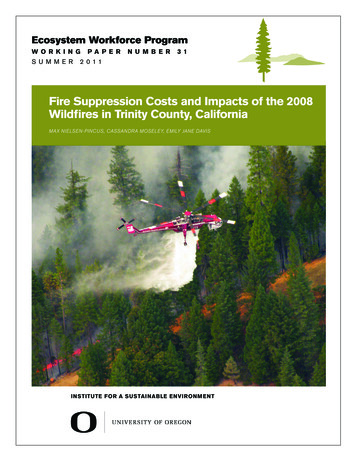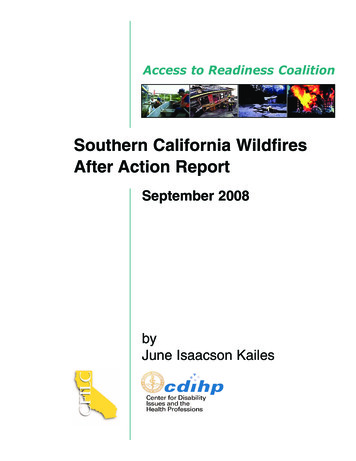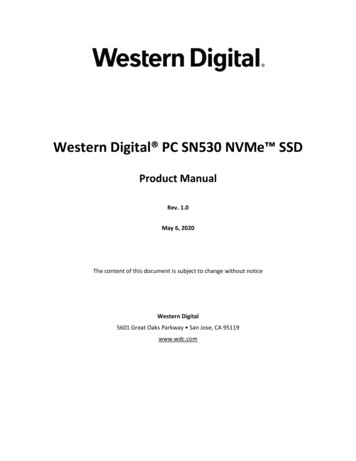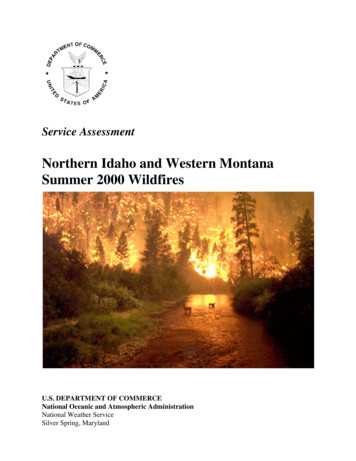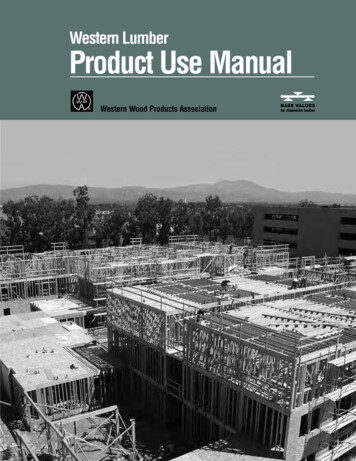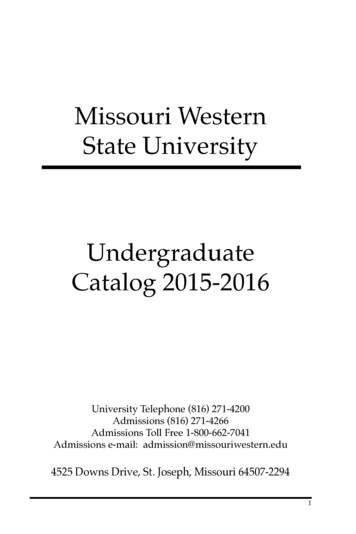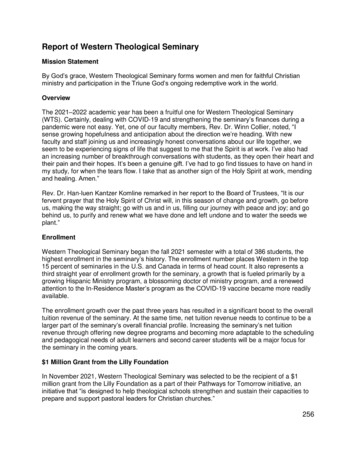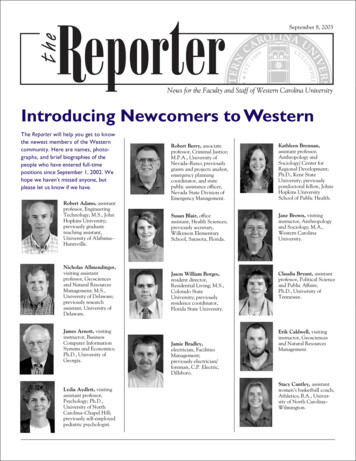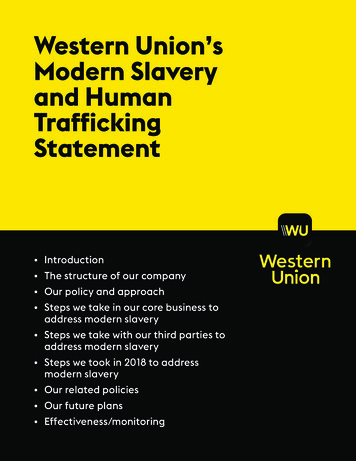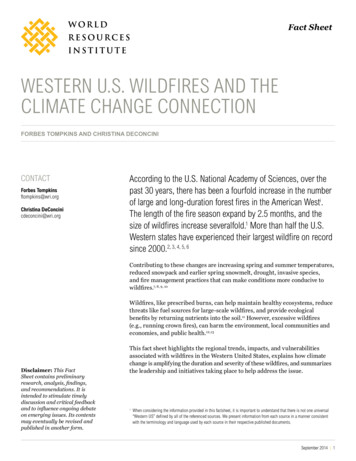
Transcription
Fact SheetWESTERN U.S. WILDFIRES AND THECLIMATE CHANGE CONNECTIONFORBES TOMPKINS AND CHRISTINA DECONCINICONTACTForbes Tompkinsftompkins@wri.orgChristina DeConcinicdeconcini@wri.orgAccording to the U.S. National Academy of Sciences, over thepast 30 years, there has been a fourfold increase in the numberof large and long-duration forest fires in the American Westi.The length of the fire season expand by 2.5 months, and thesize of wildfires increase severalfold.1 More than half the U.S.Western states have experienced their largest wildfire on recordsince 2000.2, 3, 4, 5, 6Contributing to these changes are increasing spring and summer temperatures,reduced snowpack and earlier spring snowmelt, drought, invasive species,and fire management practices that can make conditions more conducive towildfires.7, 8, 9, 10Wildfires, like prescribed burns, can help maintain healthy ecosystems, reducethreats like fuel sources for large-scale wildfires, and provide ecologicalbenefits by returning nutrients into the soil.11 However, excessive wildfires(e.g., running crown fires), can harm the environment, local communities andeconomies, and public health.12,13Disclaimer: This FactSheet contains preliminaryresearch, analysis, findings,and recommendations. It isintended to stimulate timelydiscussion and critical feedbackand to influence ongoing debateon emerging issues. Its contentsmay eventually be revised andpublished in another form.This fact sheet highlights the regional trends, impacts, and vulnerabilitiesassociated with wildfires in the Western United States, explains how climatechange is amplifying the duration and severity of these wildfires, and summarizesthe leadership and initiatives taking place to help address the issue.i hen considering the information provided in this factsheet, it is important to understand that there is not one universalW“Western US” defined by all of the referenced sources. We present information from each source in a manner consistentwith the terminology and language used by each source in their respective published documents.September 2014 1
LOCAL TRENDS, IMPACTS,AND VULNERABILITIESFigure 2 The annual national cost of putting out wildfires hasexceeded 1 billion (in 2014 dollars)15 since 2000,and both the acreage burned and the cost to suppresswildfires has grown significantly in each of the lastthree decades (see Figures 1 and 2).16 One of themost significant contributors to the cost of wildfiresuppression is growing population along the “wildfireurban interface,” where human development meetsnatural areas like forests.17 Other factors contributingto these costs include the large amount of acreageburned and the severity and duration of wildfires,all of which are impacted by climate change.18, 19, 20Figure 1 ce: National Interagency Fire Center adjusted for inflation (2014 dollars).22 Washington State witnessed its largest wildfire in umulative U.S. ForestCAcres Burned Since 1985recorded history in 2014, burning more than 250,000acres (more than six times the size of San Francisco)and 300 homes.23, 2470National Acres Burned (millions)18National Suppression Costs (billions)Individual wildfires are mentioned in this section toprovide information regarding the magnitude of impactsthese types of events are already causing. No singlewildfire can be attributed to climate change. However,research shows that climate change is increasing theduration and severity of wildfires in certain regions, andis expected to continue doing so in a warmer world.14 umulative U.S. FireCSuppression Costs Since 1985 Colorado’s 2013 Black Forest Fire was the mostdestructive wildfire in the state’s history in terms ofproperty loss, destroying more than 500 homes andcausing more than 420 million in estimated insuredlosses.25, 266050 In Arizona and New Mexico, record 2011 wildfires40scorched record amounts of land combining to burnnearly 700,000 acres (more than three times the sizeof New York City).27, 283020 Jonathan Overpeck, Co-Director of the Institute forEnvironment and a professor of geosciences andatmospheric sciences at the University of Arizonastated (May, 2014):1001985–19941995–20042005–2013Source: National Interagency Fire Center adjusted for inflation (2014 dollars).212“The fires in California and here in Arizona are aclear example of what happens as the Earth warms,particularly as the West warms, and the warmingcaused by humans is making fire season longer andlonger with each decade.”29
Western U.S. Wildfires and the Climate Change Connection Evidence demonstrates that the wildfire season in theU.S. West has grown since the 1970s, extending froman average of approximately five months to more thanseven months, according to Climate Central.30 The average number of annual large-scale wildfires(wildfires that burn more than 1,000 acres) has almostquadrupled in Arizona and Idaho since the 1970s,while doubling in California, Montana, New Mexico,Oregon, Utah, and Wyoming.31 Statement by the Western Governors’ Association(August, 2014):“Over the past decade, wildfires have increased in sizeand intensity and the fire season now extends 60–80days longer than historic averages.”32 Wildfires decreasing air quality and harming humanhealth has been well-established.33 Exposure to smoke from wildfires increasesthe number of hospitalizations and medicalvisits associated with health issues like asthma,bronchitis, respiratory infections, and lungillnesses.34, 35 In Nevada’s Reno/Sparks area alone, the 2008 fireseason resulted in almost 2 million in hospitalcosts from wildfires within a 350-mile radius.36THE CLIMATE CHANGE CONNECTIONExperts and research on the connection between wildfiresand climate change. Philip Dennison, fire expert and professor of geographyat the University of Utah stated (May, 2014):“We are going to see increased fire activity all acrossthe West as the climate warms.”38 Research shows that climate change has been asignificant driver of changes in Western U.S. fireactivity.39, 40 Increases in spring and summer temperatures, aswell as earlier spring snowmelt, have been stronglyconnected with longer lasting wildfires and morefrequent large wildfires.41 Wildfire risk is increasing significantly in the WesternU.S. partly due to warmer and drier conditions, whichcan increase the flammability of vegetation and createmore potential fuel for fires. These risks are expectedto increase as global temperatures rise, likely leadingto more frequent large wildfires.42, 43, 44, 45, 46 Beetle outbreaks can lead to substantial trees deathsthat provide more short-term fuel for wildfires.Warmer temperatures create conducive conditions forbeetle outbreaks because more beetles survive warmerwinters and reproduce more over longer warm seasons.The impacts of climate change provided favorableconditions for recent unprecedented mountain pinebeetle outbreaks in high-elevation communities acrossthe Western U.S.47, 48 Between 2000 and 2010, more than 43 millionacres (larger than the size of New England) offorests in the Western U.S. were harmed by barkbeetles.49, 50 Elizabeth Reinhardt, Assistant Director, Fire andAviation Management of U.S. Forest Service stated(September, 2013):“The frequency, severity, and extent of wildfires arestrongly linked to climate. In a warming climate, weare experiencing earlier snowmelt, lower summersoil moisture and fuel moisture, more drought, andlonger fire seasons. Collectively, these conditions haveled to increases in fire extent and challenges for landmanagers.”37September 2014 3
LOCAL LEADERS RESPONDING,ACTION PLANS, AND RESOURCESLeaders in the Westernii states are responding to thechallenge of climate change:Number of local elected official signatories of the ResilientCommunities for America Agreement51—a pledge to createmore resilient cities, towns, and counties to challengeslike climate change—in the Western U.S. as of September,2014:Arizona: 13California: 138Idaho: 7Montana: 22Nevada: 5Oregon: 16Utah: 4Washington: 34Number of signatories of the U.S. Mayors’ ClimateProtection Agreement52—a pledge by mayors to takeaction to reduce carbon emissions from city operationsand as a community—in the Western U.S. as ofSeptember, 2014:Arizona: 6California: 3Idaho: 2Montana: 2Nevada: 0Oregon: 3Utah: 2Washington: 3iiiii4Examples of State and Local Responses toWildfires in the Western U.S.States and localities throughout the Western U.S.iiiare taking steps to address the risk of wildfires. Fromeducational fire prevention tools and materials, tocomprehensive community wildfire protection plans,to statewide fire mitigation plans, action is being takenacross the region to better prepare for wildfires andreduce the potential for costly impacts.Arizona: Community Wildfire Protection Plans53California: Cal-Adapt Wildfire Fire Risk Map54Idaho: Idaho Firewise55Montana: FireSafe Montana56Nevada: Wildland Fire Protection Program57Oregon: Oregon Climate Change Research Institute58Utah: Communities at Risk to Wildland Fire Tool59Washington: Washington State HazardMitigation Plan—Wildland Urban Fire Profile60The Western U.S. as defined by the National Oceanic and Atmospheric Administration (http://www.nws.noaa.gov/om/csd/index.php?section programs)The Western U.S. as defined by the National Oceanic and Atmospheric Administration. (http://www.nws.noaa.gov/om/csd/index.php?section programs)
Western U.S. Wildfires and the Climate Change ConnectionENDNOTES1. http://www.nap.edu/openbook.php?record id 12782&page R131. ires2012.pdf2. ctsheets/20LACRES.pdf32. http://www.westgov.org/images/wildfire letter final.pdf3. http://www.ncdc.noaa.gov/sotc/fire/2011/1334. fire-RespiratoryReview-2011.pdf4. lab forestry/files/TrueCostOfWilfire.pdf33. http://www.ncdc.noaa.gov/sotc/fire/2011/1335. http://oem.bmj.com/content/66/3/189.abstract5. ads/RRU SectionEight Fire.pdf36. http://www.ucsusa.org/assets/documents/global warming/playingwith-fire-report.pdf6. http://www.ncdc.noaa.gov/sotc/national/2014/737. er%202013%20Climate%20Update.pdf7. ge Firest Fire.pdf8. /whitebarkpine/TempFR07182011.pdf38. orse-due-globalwarming39. 59576/abstract9. http://tenaya.ucsd.edu/tioga/pdffiles/Westerling wildfire jan2008.pdf40. ge Firest Fire.pdf10. 59576/abstract41. www.fsl.orst.edu/wpg/events/W11/ClimateChange Firest Fire.pdf11. Fire%20Case%20Studies.Feb06.pdf42. 59576/abstract12. re report.pdf43. www.fsl.orst.edu/wpg/events/W11/ClimateChange Firest Fire.pdf13. http://www.fs.fed.us/rm/pubs other/rmrs 2012 richardson l001.pdf44. http://www.usda.gov/oce/climate change/effects 2012/FSClimate1114%20opt.pdf14. ests45. http://www.fs.fed.us/rm/pubs other/rmrs 2012 litschert s001.pdf15. http://www.bls.gov/data/inflation calculator.htm46. http://ulmo.ucmerced.edu/pdffiles/09EA Littelletal.pdf16. http://www.nifc.gov/fireInfo/fireInfo documents/SuppCosts.pdf47. http://cals.arizona.edu/extension/fh/bb faq.html#117. 9.pdf48. /whitebarkpine/TempFR07182011.pdf18. of%20Inaction.pdf49. tle/FY2012WBBS AccomplishmentReport.pdf19. http://www.fs.fed.us/documents/USFS An Overview 0106MJS.pdf50. http://quickfacts.census.gov/qfd/index.html20. er%202013%20Climate%20Update.pdf51. iew-the-signatories/21. http://www.bls.gov/data/inflation calculator.htm22. http://www.bls.gov/data/inflation calculator.htm23. http://www.ncdc.noaa.gov/sotc/national/2014/724. http://quickfacts.census.gov/qfd/index.html25. http://www.ncdc.noaa.gov/sotc/national/2013/626. www.rmiia.org/catastrophes and statistics/Wildfire.asp27. http://www.ncdc.noaa.gov/sotc/fire/2011/1328. http://quickfacts.census.gov/qfd/index.html29. orse-due-globalwarming30. ires2012.pdf52. t.htm53. https://azsf.az.gov/Arizona-cwpp54. http://cal-adapt.org/fire/55. p-idaho-green/56. http://firesafemt.org/57. http://forestry.nv.gov/fire-program/58. ality59. ap 1344a0880bb1444baf7332b58e7276fb&extent -116.8964,36.1207,-106.1298,42.81260. http://www.emd.wa.gov/plans/documents/Wildland Fire HazardProfile.pdfSeptember 2014 5
ABOUT WRIWRI is a global research organization that works closely with leaders to turnbig ideas into action to sustain a healthy environment—the foundation ofeconomic opportunity and human well-being.Our ChallengeNatural resources are at the foundation of economic opportunity and humanwell-being. But today, we are depleting Earth’s resources at rates that arenot sustainable, endangering economies and people’s lives. People dependon clean water, fertile land, healthy forests, and a stable climate. Livablecities and clean energy are essential for a sustainable planet. We mustaddress these urgent, global challenges this decade.Our VisionWe envision an equitable and prosperous planet driven by the wisemanagement of natural resources. We aspire to create a world where theactions of government, business, and communities combine to eliminatepoverty and sustain the natural environment for all people.Our ApproachCOUNT ITWe start with data. We conduct independent research and draw on thelatest technology to develop new insights and recommendations. Ourrigorous analysis identifies risks, unveils opportunities, and informs smartstrategies. We focus our efforts on influential and emerging economieswhere the future of sustainability will be determined.CHANGE ITWe use our research to influence government policies, business strategies,and civil society action. We test projects with communities, companies,and government agencies to build a strong evidence base. Then, we workwith partners to deliver change on the ground that alleviates poverty andstrengthens society. We hold ourselves accountable to ensure our outcomeswill be bold and enduring.SCALE ITWe don’t think small. Once tested, we work with partners to adopt andexpand our efforts regionally and globally. We engage with decision-makersto carry out our ideas and elevate our impact. We measure success throughgovernment and business actions that improve people’s lives and sustain ahealthy environment.Copyright 2014World Resources Institute. This work is licensed under the Creative Commons Attribution-NonCommercial-NoDerivativeWorks 3.0 License. To view a copy of the license, visit 0 G Street, NE Washington, DC 20002 www.WRI.org
California: 138 Idaho: 7 Montana: 22 Nevada: 5 Oregon: 16 Utah: 4 Washington: 34 Number of signatories of the U.S. Mayors' Climate Protection Agreement52—a pledge by mayors to take action to reduce carbon emissions from city operations and as a community—in the Western U.S. as of September, 2014: Arizona: 6 California: 3 Idaho: 2 Montana: 2
